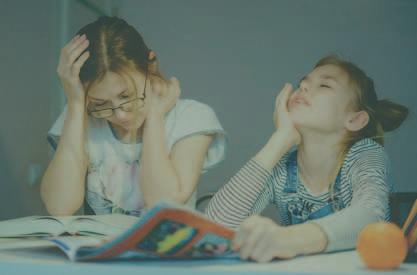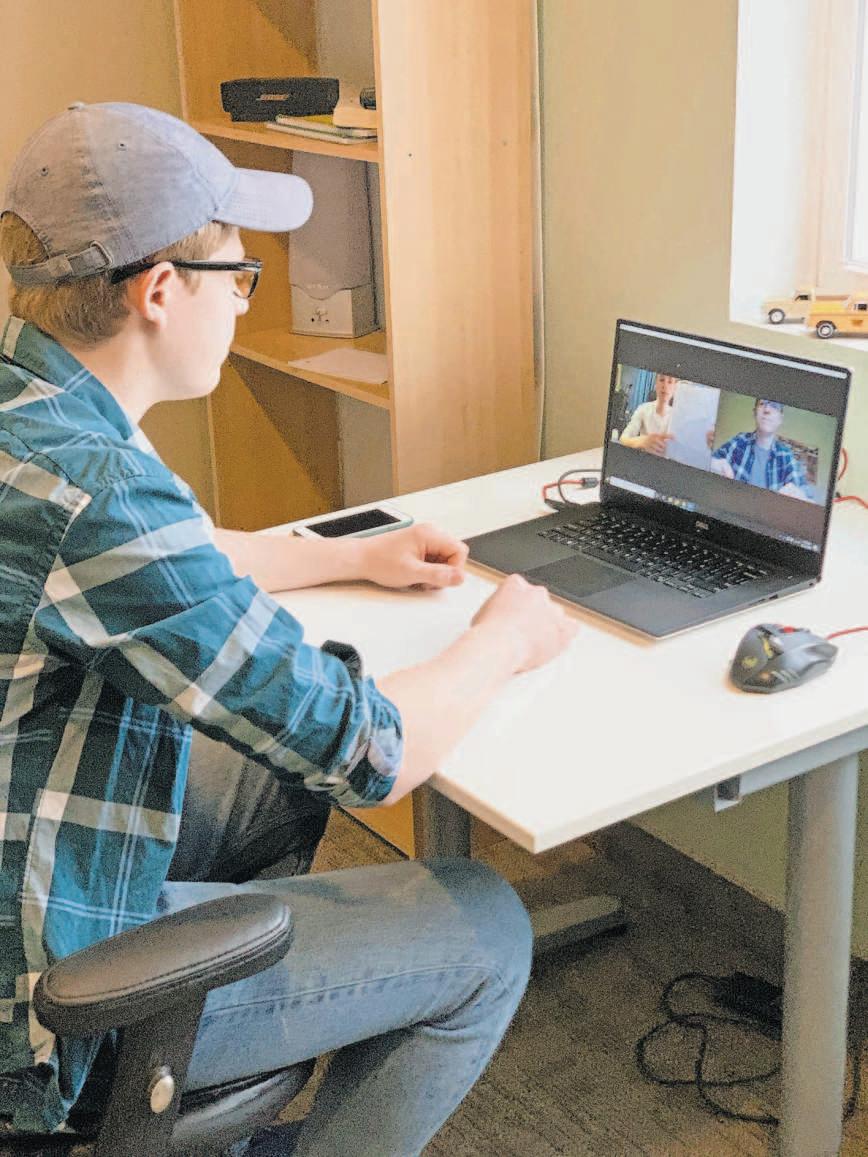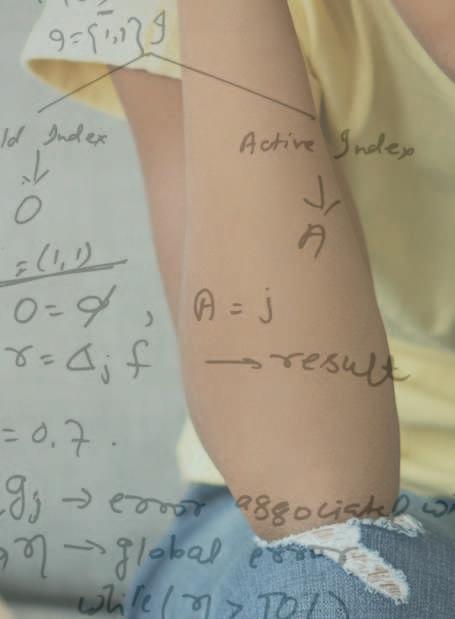
8 minute read
LESSONS LEARNED
USATODAYSPECIALEDITION
EDUCATION
Advertisement









PHOTO ILLUSTRATION: DEBRA MOORE; GETTY IMAGES
USATODAYSPECIALEDITION
says. Because Orange County still needs a push (to complete Public Schools allowed students assignments),” Brown says. Even to choose either in-person or though his son logs onto class virtual learning, teachers had been diligently, he says, “After a while, shuffled to accommodate the new the kids are just over it. You’ve bifurcated reality. really got to stay on them. For
“The county did a good job of parents, helping your kids in letting the teachers decide if they school is your new job.” wanted to (work) face to face or There has been a push-pull efvirtual, but every quarter that fect between parents and students has to be rebalanced as more kids who would prefer to reinstate decide to come back (in person),” in-person classes and teachers Leneis says. It’s just one of the unions, some of which, including many scenarios that has affected the United Federation of Teachmore than 56 million school-age ers , have demanded all-virtual children in the United States programs and threatened to strike during the COVID-19 pandemic. if schools are reopened during the
Former science teacher pandemic . Eddie Brown , a Houston-based Beyond educating students, comedian known professionally schools provide a host of as Eddie B., offers daily virtual other valuable services. There are comedy sessions with teachers concerns that cases of abuse or from around neglect will the world, go unreported adding a bit of because chilhumor to what dren are cut off can be chal- STUDENTS ENROLLING IN from physical lenging days. “I COLLEGE IMMEDIATELY interactions tell them, ‘You AFTER HIGH SCHOOL with teachers can now add DECLINED and professionto your résumé als who might that you’re a certified IT specialist,’” he says, 21.7 % otherwise make a report. According to Childhelp , a highlighting nonprofit for the extra layer IN 2020 the prevention of technology and treatment teachers must SOURCE: National Student Clearinghouse Research Center of child abuse, contend with more than 3.6 while leading million referdistance rals involving learning. more than 6.6 million children are
When pandemic shutdowns made each year to child protection started last spring, school systems agencies in the United States . scrambled to adjust curriculums, The Brookings Institute reported organize videoconferencing tools that in March 2020 states such and make sure students had as Illinois, Oregon, Pennsylvania access to the internet and the and Wisconsin saw reports of necessary technology. In August, child abuse fall by 20 percent to Atlanta public schools approved 70 percent, primarily as a result a nearly $25 million contract to of reduced contact with teachers, lease up to 40,000 iPads and doctors, day care providers and Chromebooks to ensure that all other mandated reporters. students have a device on which to learn. UNEXPECTED BENEFITS
Likewise, parents were forced to Nicole Beurkens is a licensed get creative and carve out at-home clinical psychologist with spaces for kids to learn, time to advanced degrees in education, supervise virtual school, and nutrition and psychology; she’s for those whose jobs take them also a mother of four children, two outside the house, to organize of whom are engaged in distance child care during the day. “My learning through their Grand 13-year-old son is doing remote learning. He’s very smart, but he CONTINUED
USATODAYSPECIALEDITION
ADVERTISEMENT

EDUCATION




ELISE KUTT “For the majority of kids, I’m not worried about long-term fallout. ... I have significant concern for (those) for whom school is their only access point for caring supportive adults and for exposure to reading, writing and math.”
— NICOLE BEURKENS, clinical psychologist



PHOTO ILLUSTRATION: DEBRA MOORE; GETTY IMAGES
USATODAYSPECIALEDITION
High school student Nate Beurkens
PROVIDED BY NICOLE BEURKENS
Rapids, Mich., public schools. She says that while challenges abound, “some kids have done markedly better. Kids who were overwhelmed by the (traditional) school environment or needed, but were not getting, one-on-one or small-group instruction have done much better in this situation.”
Beurkens notes that most educators have to teach to the middle of the class. In a virtual environment, students who finish work quickly can pursue their additional academic and extracurricular interests, while students with mild to moderate learning challenges can access smaller group instruction with greater explanation or repetition as needed.
“One of the big benefits has been that schools are willing to be more flexible,” Beurkens says. “For the majority of kids, I’m not worried about long-term fallout in terms of learning and education.” She points out that children are also learning practical skills at home — things like personal finance, cooking or doing laundry — that will serve them well in life.
The pandemic has created advantages for some students, but for others, it’s been a setback. “I have significant concern for the segment of the population of kids for whom school is their only access point for caring supportive adults and for exposure to reading, writing and math,” Beurkens says. “For those kids, the longer they’re out of school, the more that gap widens, and the more work is going to need to be done to help support them and catch them up.” Lack of parental support, resources such as connectivity or books, and access to proper nutrition can all be detriments to learning, she says. POSTSECONDARY CHANGES
Prior to COVID-19, some universities, such as UCLA, were considering abolishing standardized testing as a basis for admission. But the pandemic’s disruption of typical school patterns “is causing standardized tests like the SAT and ACT to become even more necessary,” says Matt Larriva , founder of Powerful Prep, a California-based company offering college admission test preparation services . “Those tests allow college administrators to look at students on an apples-to-apples basis. Opponents will say, ‘Why don’t you just look at GPA?’ But ... with the well-documented grade inflation problems, it’s really hard to pick which student is qualified to attend a certain university (under normal circumstances),” he says, noting that a year of remote education is likely to exacerbate those issues.
In many communities across the country, ACT and SAT testing has been canceled or limited . Partially in response to this, more than 400 colleges and universities have made their application processes test-optional for the 2020-2021 admissions cycle .
In December, the National Student Clearinghouse Research Center released its annual high
CONTINUED
USATODAYSPECIALEDITION

EDUCATION


PROVIDED BY MATT LARRIVA


— MATT LARRIVA, founder, Powerful Prep
PHOTO ILLUSTRATION: DEBRA MOORE; GETTY IMAGES
USATODAYSPECIALEDITION
school benchmarks report showing that, while COVID-19 had little impact on high school graduation rates, the number of students who went to college immediately after high school declined 21.7 percent from the previous year. And, as of Dec. 18, the number of students who had filled out the Free Application for Federal Student Aid was down 12.7 percent , indicating that 2021 college admissions may also be proportionately lower.
The long-term economic impact could be significant. A report issued by the United Nations’ Organization for Economic Co-operation and Development estimated that in the United States alone, pandemic-related school closures in 2020 will result in future GDP losses of between $14 trillion and $28 trillion.
Larriva is optimistic that the pandemic’s effects on education will open minds to alternate learning and career paths. “I’m hoping that some students feel it’s destigmatized to not go to college (if it’s not right for them). They might take an opportunity to go to a coding boot camp or look into an advanced trade program,” he says. “There’s some real potential for some positive shifts to come out of all of this.”
It’s too early to tell what the long-term effect of the pandemic will be, both on the educational system broadly and on individual students. “We’re looking probably at a year to five years out to really see the impact of this as kids progress,” says Beurkens.
For now, Beurkens recommends parents focus on their child’s individual needs, academically and emotionally, as schools and teachers continue to make adjustments.
Temperature screening at a STEM camp in Wylie, Texas
LM OTERO/ASSOCIATED PRESS
USATODAYSPECIALEDITION










